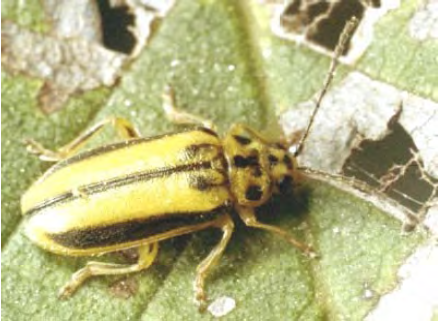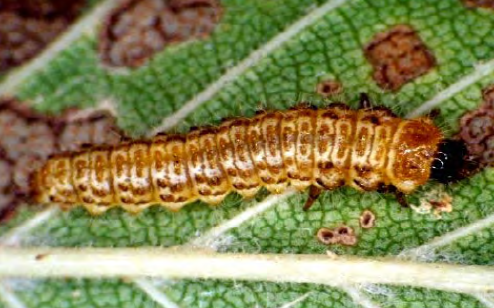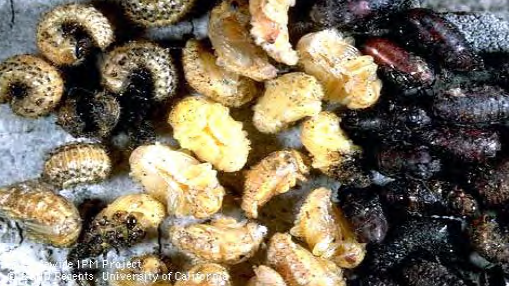Introduction
Although elm leaf beetles attack many species of elm, they feed mainly on Siberian elms (Ulmus pumila) in northern Nevada. In the summer their larvae feed on leaves, turning them brown. Leaves will have a “lacey” appearance with brown “netting,” and often the leaves drop. Although not life threatening to the tree, the feeding larvae can weaken the tree.
Life Cycle
Elm leaf beetles have at least one generation a year in northern Nevada and two to three generations a year in southern Nevada.
In spring, after elm trees have leafed out, winged adults emerge from winter hibernation and immediately fly to the foliage of elm tree leaves. After feeding on the foliage for a few days, five to 25 yellowish eggs are laid by the female in clusters of double rows on the undersides of the leaves (Figure 1). A female can lay 400 eggs to 800 eggs in one season.

Fig. 1. Mature adult left, young larvae center and cluster of eggs to the right.
Eggs hatch in about a week. The eggs turn a grayish to black color, signaling their emergence from egg to larvae.
The pale yellow larvae have two dark stripes down their body and feed on the leaves for several weeks as they develop toward maturity (Figure. 2).

Fig. 2. Elm leaf beetle larvae.
When the larvae mature, they crawl down the tree trunk, becoming curled, inactive pupae at the base of the tree (Figure 3). Approximately 10 days later, in late spring or summer, adult beetles emerge from their pupae and fly to canopies of the nearest elm trees. The winged beetles then feed again on leaves and lay more eggs to complete their life cycle.

Fig. 3. Elm leaf beetle pupal or resting stage.
As summer ends and fall begins, the adult elm leaf beetles seek out protected sites where they can hibernate. They overwinter in crevices of trees, leaf litter, woodpiles, siding and roof shingles.
Damage
The elm leaf beetle larvae skeletonize leaf surfaces by eating the leaf without breaking through the opposite surface or eating the vein. Adult beetles chew through the entire leaf, often leaving a shothole pattern (Figure 4). Leaves frequently curl and prematurely drop during this time. Consequently, summer shade is reduced and many of the remaining leaves turn brown. If extensive defoliation continues, the elm weakens and will continue to decline over the years.
Cultural Management
During the summer, supply elm trees with supplemental water. Healthy vigorous trees can withstand an attack and defoliation better than drought stressed trees.
Controlling Elm Leaf Beetles in the Home
Adult elm leaf beetles may enter homes in fall through cracks, doors and windows to hibernate and can be a nuisance. Remove wayward insects by vacuuming or sweeping them up with a broom and dust pan. To prevent insects from entering homes, caulk cracks and crevices around doors, windows and foundations and other entry points.
To kill adult beetles, use household pressurized aerosol sprays containing pyrethrum. Spray directly on the beetles. After they die, sweep them up and discard them.
IPM Pest Management
An integrated pest management (IPM) approach is the preferred method to controlling these pests. This includes keeping pest populations to a tolerable level using a variety of techniques rather than continuously and indiscriminately spraying with an insecticide that kills beneficial insects, as well as the beetles. IPM methods and techniques include using biological controls, such as Bt (Bacillus thuringiensis, subspecies tenebrionis); bark banding techniques (applying a broad band of insecticide near the base of trees using a hand sprayer); foliar spraying in conjunction with bark banding; systemic insecticides that are absorbed through the leaves; soil drenching of systemic insecticides (adsorbed through the roots); and root and trunk injections that are adsorbed through the trunk.
Bark Banding
Bark banding is applying a pesticide to the tree trunk. It is applied using a pressurized spray tank. The pesticide is sprayed in a band several feet wide around the trunk above ground level to the first set of branches.
Banding minimizes pesticide spray drift that otherwise can harm or kill nontarget or beneficial insects. Banding is only effective if adjacent trees are treated at the same time. In addition, if beetles are abundant, expect little or no control the first year. Bark banding will not provide satisfactory control in all situations. If only a few trees are treated, adults will fly to untreated trees and begin to feed.
In the spring, after the beetles feed on the foliage and before the larvae crawl down the trunk to pupate, band trees with either carbaryl (Sevin® with 2% active ingredient) or a botanical insecticide (Pyrethrum or Pyrethorid, synthetic pyrethrum). Apply pesticides around the base of the trunk and several feet up to the first set of the main branches. This reduces next year’s generation of beetles. Apply at the labeled rate for trunk applications.
A single application of carbaryl to the bark each spring will last for nearly a season. However, monitoring for dead beetles/larvae at the base of the tree throughout summer and fall is suggested to ensure that the pesticide is still effective. In some cases when trees are “banded,” the spray may persist and it may not be necessary to treat the tree the following year.
Be aware if bark banding is done in Northern Nevada before the larvae crawls down the trunk, the existing larvae (first generation) will feed and defoliate the leaves before they come in contact with the pesticide. As a result, damage to the tree will be evident the first year.
Foliar Spraying
Foliar spraying is effective when an application of a registered insecticide is timed to impact the first and second generation of larvae. This is done in late May, June, July or early August. However, like banding, if only a few trees are treated, the adult beetles will fly to untreated trees and begin to feed. Also, spraying may be appropriate to supplement banding during the first year or two of treatment or when early-season beetle populations are high.
There are many insecticides available for foliar applications and labeled for control of elm leaf beetle. Examples of labeled insecticides include acephate (Orthene®), carbaryl (Sevin®), permethrin (Astro®) and neem oil (Neemazad®).
Systemic Insecticide
Systemic insecticides are either sprayed on the tree, adsorbed by the root system by a soil drench, or injected directly beneath the bark of the trunk or root of the tree and carried systemically to the leaves where beetles feed. Follow the label direction for application rates and timing. Examples of systemic insecticides include abamectin (Avid II®) acephate (Orthene®), imidacloprid (Bayer Advanced Tree and Shrub Insect Control®, Imicide®, Merit® and Pointer®).
Soil Drenching
Soil drenching involves pouring a mixture of water and a systemic insecticide directly over the root system of the plant where it is adsorbed. The systemic is then carried to the leaves where beetles feed. Some systemic insecticides can also be tilled into the soil.
Soil drenching is a preferred method of control over spraying. Drift from the insecticidal sprays can sometimes kill nontarget beneficial pests. In certain cases spraying can become ineffective because pests can develop a resistance to an insecticide.
A soil drench application is preferred and is applied in the fall or in spring, before the tree “leafsout” and before it rains. Examples of insecticides used for soil drenching include products that contain imidacloprid, such as Bayer Advanced Tree and Shrub Insect Control®, Merit® and Pointer®.
Trunk and Root Injections
Injection is the process of introducing a pesticide into the vascular system of the tree. Holes are usually drilled into the trunk and roots, and then narrow tubes of pressurized insecticide are secured in place. The tree then carries the insecticide to the leaves where beetles feed. Imidacloprid or abamectin insecticides are often used for this purpose. Repeated applications are not recommended because bacteria can enter the wounds. (See Bacterial Wet Wood and Alcoholic Flux, Fact Sheet 03-33.) Also, repeated injections may interfere with the flow of water and weaken the tree. Reduce the chance of damaging the tree by hiring experienced, licensed pesticide applicators or trained, certified arborists to make the injections.
Biological and Botanical Controls
There are several biological and botanical pesticides registered for controlling elm leaf beetle. Biological controls include the bacteria Bt (Bacillus thuringiensis sp. “tenebrionis” or “san diego” strains). Bt is readily available and is a naturally occurring bacterium commonly found in soils throughout the world. Several strains can infect and kill insects.
It is mixed with water and sprayed on the leaves when larvae are present. Several days after the larvae ingest the bacteria, certain poisons, called delta-endotoxins, are released. This causes the larvae to stop feeding. The larvae then starve and die.
Other biological controls include insect predators that are native, natural enemies of the elm leaf beetle. These insects generally do not provide adequate control by themselves. An example is the black tachinid fly (Erynniopsis antennata) that parasitizes the beetle larvae and is native to California. Another example is the tiny wasp (Baryscapus brevistigma) that survives in the Midwest and parasitizes the beetle eggs. Predatory flies, wasps and mites are also available. However they are not very effective.
Botanical Control
Examples of botanical insecticides used to control elm leaf beetle include azadirachtin (Neemazad®) and pyrethrums.
Neemazad®, a botanical broad-spectrum insecticide, contains natural extracts from the seeds of the neem tree, Azadirachta indica. These extracts are natural insect growth regulators that inhibit adults from laying eggs when they come into contact with the insecticide. Neemazad® also disrupts the molting process when immature insects are exposed to this material.
Another botanical insecticide with very short persistence is pyrethrum. This compound is extracted from the daisy, Chrysanthemum cinaeriofolium. Pyrethrum has a rapid "knock-down" effect on insects, but insects may recover from the spray. Most botanical insecticides will not provide adequate control. However when used in combination with beneficial insects (bees, predatory wasps and mites, lacewing larvae and ladybird beetles), they can be very effective in managing elm leaf beetles.
Pesticides
When applying any pesticide, always follow the manufacture’s recommendations and rates.
Summary
Elm leaf beetles can be effectively controlled using any of the controls mentioned. However, keeping trees healthy by properly watering and fertilizing will be your best line of defense against any infestations from insects or diseases.
Reference
Crenshaw W.S. and Zimmerman R.J. 2002. Elm Leaf Beetles. Fact Sheet No. 5.521. Colorado State University Educational Publications.
Hoover A.G. 2001. Elm Leaf Beetle. Pennsylvania State University. Entomological Notes: TS-13
Johnson W.T. and Lyon H.H. 1991. Insects that Feed on Trees and Shrubs. Comstock Publishing and Associates, Cornell University Press. Ithaca NY.
Lyon F.W. 2000. Elm Leaf Beetle. Ohio State University Extension. Fact Sheet HYG-2036-94.
University of California Division of Agriculture and Natural Resources. 2004. Pests of landscape trees and shrubs. Pub. 3359
Carlos, W., Davison, J., and Knight, J.
2004,
Elm Leaf Beetle,
2004


